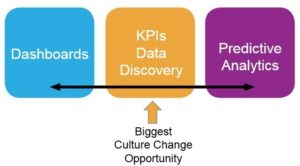ASAE’s recent publication, Focus on What Matters outlines a 3-step framework for selecting and sunsetting association programs, products, and services. What is fascinating to me is how closely this process parallels aspects of the decisions we make when we undertake an association analytics initiative. The author, Mariah Burton Nelson, describes the need to take a strategic, disciplined, data-informed approach to focus on what really matters.
The initial steps to implement the Focus Framework are similar to those we follow with association analytics:
- Secure Board support
- Create the internal team: People who help create a system will support it. However the larger the team, the slower the process. Find a balance between inclusion (which improves adoption) and streamlined decision-making (which speeds time to results)
- Prioritize the area to focus on first. There is no one “right” place to start – it depends on your organization’s priorities
Frameworks
In business we often think in terms of frameworks because they simplify complex concepts or processes. Once we select a framework, we can then follow the Pareto Principle for implementation (20% of the processes are responsible for 80% of the results). The ASAE Focus Framework starts with idea generation, followed by product review and portfolio analysis:
I see a clear parallel to data analytics, moving from lots of detail in the “Idea Generation” step, to less detail but very high value at the “Portfolio Analysis” step. With data analytics we can group in terms of operational (dashboards), tactical (KPIs and data discovery) and strategic (predictive analytics):
Dashboards: Many dashboards are operational and deal with transactional data. They provide a way to do what you already do, but in a more efficient/effective manner, using data visualization.
KPI’s and Data Discovery: Analytics in this group include both tactical (KPIs) and strategic (data discovery) and is where we find the biggest opportunity to make a culture change because this is where we begin to have a “conversation with the data” that leads to the “aha” moments which generate enthusiasm and galvanize support for the initiative.
- KPIs measure performance and enable comparisons of year over year, month to month, weeks out, etc.
- Data discovery enables staff to have a “conversation with the data”
- By answering the questions we know we have, our natural curiosity leads us to ask ever better and more high value questions
- Identifies previously unknown correlations
- Helps us uncover what we didn’t know that we didn’t know (which mitigates risk!)
Predictive Modeling: Designed to help organizations make strategic decisions
- Profiling Optimal Customer by segment
- Identify Who is “At Risk” (for not renewing, not attending)
- Forecasting
- Market segmentation
- Profitability analysis
- Engagement
In the book, Mariah outlines the keys to achieving success with the Focus Framework, many of which also apply to data analytics. These three in particular will put your analytics initiative on the path to success:
- Keep it simple. One of the main reasons business analytics initiatives stall is because they start too large, become too complex and hard to understand, which results in a loss of momentum.
- Think systemically. This is critical with data analytics because we are breaking down data silos and increasing transparency. Staff will begin to think about how data in each business area within the organization affects another. Data is an organizational asset: it’s not “my” data – it’s “our” data.
- Be flexible. A flexible process that evolves over time is the definition of a learning system and is just smart business. Using an agile, iterative process to analyze data will result in the highest value to the organization and will also support the culture change that is an amazing and positive by-product of a successful association analytics initiative.





